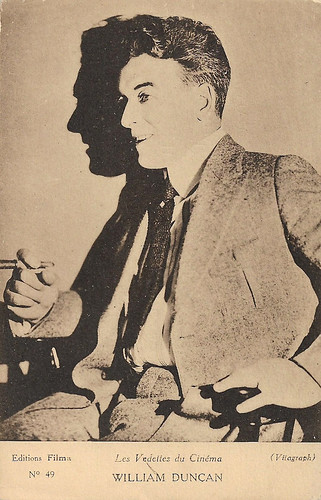
Vintage postcard.

Hungarian postcard by City. Photo: William Duncan and Edith Johnson in Big Bill Barry. While this title is lacking in IMDb, the Hungarian press advertised for this film in 1921.

French postcard in the Les Vedettes du Cinéma series by Editions Filma, no. 49. Photo: Vitagraph.
Wrestler and bodybuilder
William Duncan was born in the Lochee area of Dundee, Scotland in 1879. As a child, he immigrated to the United States with his family in 1890. They settled in Philadelphia. He attended public school, where he started to play American football. He enrolled at the University of Pennsylvania, where he played football and participated in track, but left after two years of study.
He was a wrestler and worked as a physical instructor at the McFadden Physical Culture Health Home. He also wrote for a magazine about physical culture, operated a gymnasium in Philadelphia and was a professional wrestler. Later he operated a bodybuilding academy. In 1906, Duncan debuted in Vaudeville as part of a strongman act. Next, he acted in stock theatre companies in Philadelphia, Memphis, and Rochester.
In 1909, Duncan started to appear in films at the Selig Polyscope Company. His debut was Love and Law (1909), a Selig short by Marshall Stedman. Between 1909 and 1913, Duncan acted in some thirty shorts at Selig, often Westerns. His many credits include Told in Colorado (Joseph A. Golden, 1911) and The Count of Monte Cristo (Colin Campbell, 1912), starring Hobart Bosworth as Edmond Dantes and Tom Santschi as Danglars. When this film was made Adolph Zukor had secured the rights to the 1844 novel by Alexandre Dumas Père and was about to release his 1913 version with James O'Neill who had made the role famous on stage. Zukor's attorneys ordered this film destroyed and all prints were withdrawn.
In 1914, he moved over to Vitagraph, where he continued acting in shorts. His Vitagraph contract was worth $1,000,000 a year. He was better paid than Mary Pickford and Douglas Fairbanks. From 1916, he also played for Vitagraph in features.
Probably his first feature film was God's Country and the Woman (Rollin S. Sturgeon, 1916). It was a James Oliver Curwood adaptation with Nell Shipman as the female lead. His later films include Man of Might (William Duncan, Clifford Smith, 1919), Playing It Wild (William Duncan, 1922), The Steel Trail (William Duncan, 1923) and The Fast Express (William Duncan, 1924), all with Edith Johnson as his co-star.

Portuguese postcard by Figuras do Ecran. Photo: AB.

French postcard in the Les vedettes de l'Ecran series by Editions Filma, no. 113. Photo: Evans, L.A. / Vitagraph, 1919.
Earning more than $1 million per year
From 1911 to 1924, William Duncan also directed some 88 films at Selig and Vitagraph. He directed Tom Mix in the short silent Western The Telltale Knife (William Duncan, 1914) also starring Myrtle Stedman and Duncan himself. At Selig, he also wrote almost 50 scripts.
In 1915-1916, there was a gap in his film direction, but from 1917, he continued directing at Vitagraph as well, where his first assignment was The Fighting Trail (William Duncan, 1917), a Western film series with 15 chapters.
Duncan followed the film industry to California. By now, he was directing feature-length films. Wolves of the North (William Duncan, 1924), about the adventures of fur trappers in the Pacific Northwest, was the last of his film directions.
In 1925, after having acted in some 160 films, he withdrew from the screen. But in 1935 he returned as the character Buck Peters, owner of the Bar 20 Ranch, in the Hopalong Cassidy Western series, starring William Boyd and distributed by Paramount. His last film part was in Texas Rangers Ride Again (James Hogan, 1940) starring Ellen Drew and John Howard.
Duncan married twice. In 1921, he married his second wife, silent film actress Edith Johnson, with whom he had often costarred in many of his Vitagraph productions. The couple were married until Duncan died in Hollywood, California, in 1961. He was 81. The couple had two sons and one daughter together. William Duncan was interred at Inglewood Park Cemetery, Inglewood, California, USA.

British postcard by Cinema Chat. Photo: Vitagraph.

British postcard in the Picturegoer Series, London.

Vintage Real Photograph postcard by PRC. Photo: Vitagraph.
Sources: John "J-Cat" Griffith (Find A Grave), Wikipedia and IMDb.
No comments:
Post a Comment